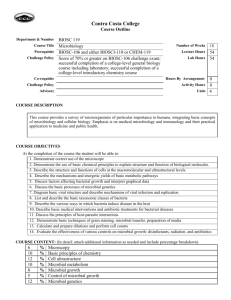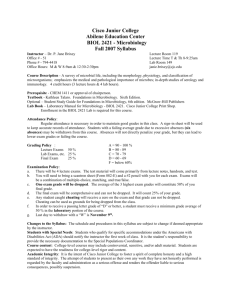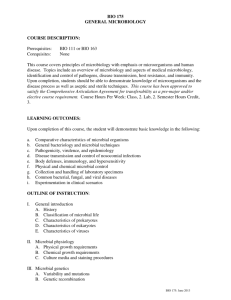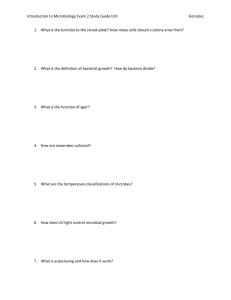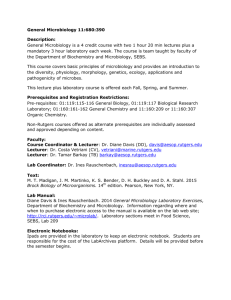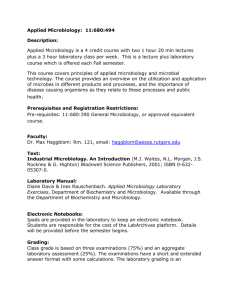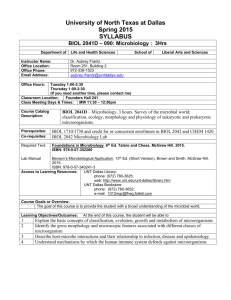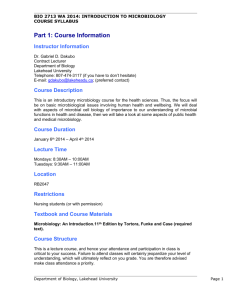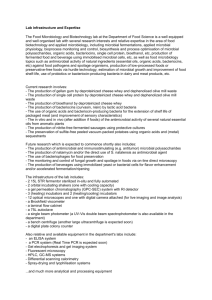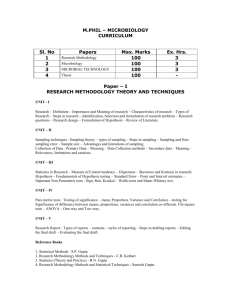ESM 214: Principles of Biological Remediation and Mitigation
advertisement
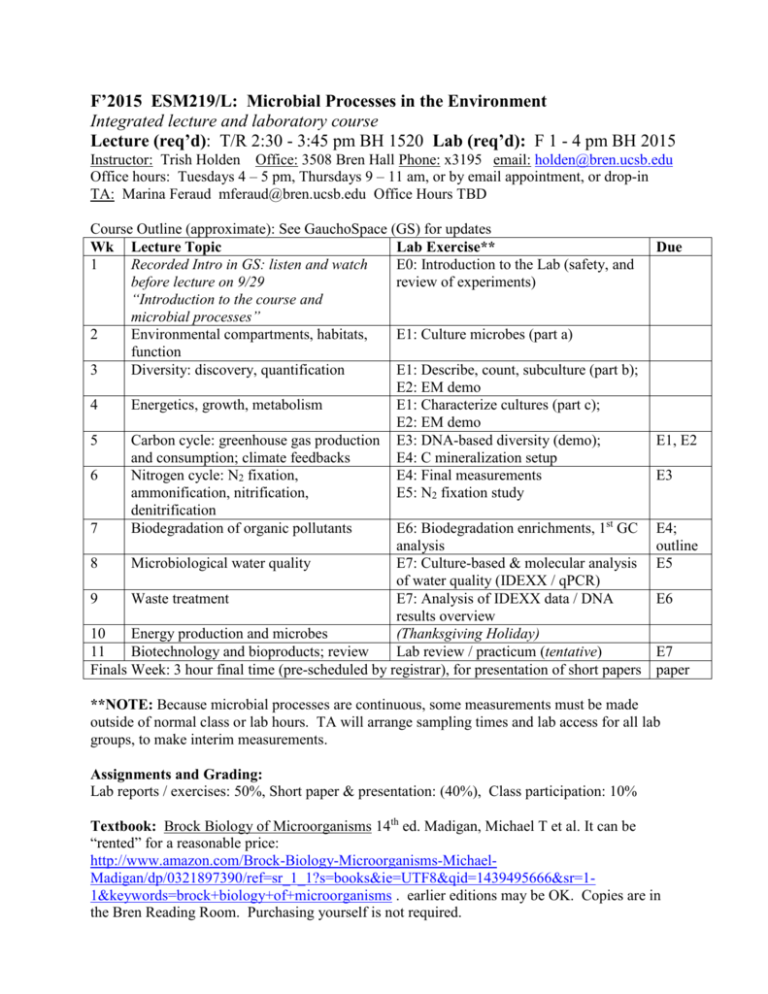
F’2015 ESM219/L: Microbial Processes in the Environment Integrated lecture and laboratory course Lecture (req’d): T/R 2:30 - 3:45 pm BH 1520 Lab (req’d): F 1 - 4 pm BH 2015 Instructor: Trish Holden Office: 3508 Bren Hall Phone: x3195 email: holden@bren.ucsb.edu Office hours: Tuesdays 4 – 5 pm, Thursdays 9 – 11 am, or by email appointment, or drop-in TA: Marina Feraud mferaud@bren.ucsb.edu Office Hours TBD Course Outline (approximate): See GauchoSpace (GS) for updates Wk Lecture Topic Lab Exercise** 1 Recorded Intro in GS: listen and watch E0: Introduction to the Lab (safety, and before lecture on 9/29 review of experiments) “Introduction to the course and microbial processes” 2 Environmental compartments, habitats, E1: Culture microbes (part a) function 3 Diversity: discovery, quantification E1: Describe, count, subculture (part b); E2: EM demo 4 Energetics, growth, metabolism E1: Characterize cultures (part c); E2: EM demo 5 Carbon cycle: greenhouse gas production E3: DNA-based diversity (demo); and consumption; climate feedbacks E4: C mineralization setup 6 Nitrogen cycle: N2 fixation, E4: Final measurements ammonification, nitrification, E5: N2 fixation study denitrification 7 Biodegradation of organic pollutants E6: Biodegradation enrichments, 1st GC analysis 8 Microbiological water quality E7: Culture-based & molecular analysis of water quality (IDEXX / qPCR) 9 Waste treatment E7: Analysis of IDEXX data / DNA results overview 10 Energy production and microbes (Thanksgiving Holiday) 11 Biotechnology and bioproducts; review Lab review / practicum (tentative) Finals Week: 3 hour final time (pre-scheduled by registrar), for presentation of short papers Due E1, E2 E3 E4; outline E5 E6 E7 paper **NOTE: Because microbial processes are continuous, some measurements must be made outside of normal class or lab hours. TA will arrange sampling times and lab access for all lab groups, to make interim measurements. Assignments and Grading: Lab reports / exercises: 50%, Short paper & presentation: (40%), Class participation: 10% Textbook: Brock Biology of Microorganisms 14th ed. Madigan, Michael T et al. It can be “rented” for a reasonable price: http://www.amazon.com/Brock-Biology-Microorganisms-MichaelMadigan/dp/0321897390/ref=sr_1_1?s=books&ie=UTF8&qid=1439495666&sr=11&keywords=brock+biology+of+microorganisms . earlier editions may be OK. Copies are in the Bren Reading Room. Purchasing yourself is not required. Other reading: Consult Gauchospace Other references: Environmental Microbiology by Raina M. Maier, Ian L. Pepper and Charles P. Gerba. 2000. Academic Press. General Microbiology by Hans Schlegel Microbial Ecology by Atlas & Bartha Soil Microbiology and Biochemistry by Paul & Clark Manual of Environmental Microbiology by ASM Press Some Relevant Websites and Users Groups: Microscopy (Microbe Zoo): http://commtechlab.msu.edu/sites/dlc-me/zoo/index.html Nanoworld Image Gallery (microbes and more): http://www.uq.edu.au/nanoworld/ Biocatalysis / Biodegradation Database http://eawag-bbd.ethz.ch/ American Society for Microbiology http://www.asm.org/ American Academy of Microbiology, Colloquia Reports http://academy.asm.org/index.php/browse-all-reports Ribosomal Database Project II (RDP, at the Center for Microbial Ecology) http://rdp.cme.msu.edu/ Center for Microbial Ecology (CME) at Michigan State: http://www.cme.msu.edu/ National Center for Biotechnology Information (NCBI) http://www.ncbi.nlm.nih.gov/ Bioremediation Discussion Group http://www.bioremediationgroup.org/ Course Goals 1. Gain working knowledge of environmental microbiology / microbial ecology, since knowledge in these areas is central to natural resource and pollution management 2. Focus on microbial processes: it is what microbes do that matters most to our interests in this course. 3. Tie knowledge to key environmental problems including climate change, energy, pollution, including relationships to public health 4. Understand how you can use understanding of microbial processes, and harness microbial activity, to solve environmental problems 5. Learn how to find information, so that you can keep your knowledge current 6. Learn the language of these fields: become conversant in the subjects, learn how to write, and present, using your knowledge gained in this course Format: This course is an integrated lecture and lab course. There are 2 classroom meetings per week, and 1 lab mtg. Lectures are designed to prepare understanding for lab, and for aiding in interpreting results for lab report writing. Read GS materials before lectures. Deliverables include lab reports with related exercises, a short term paper, and an oral presentation of the paper. Term paper topic suggestions are posted on GS. Consult instructor in selecting your topic. Submit outline with title as per Due Date. Brock (optional textbook) is a good resource. First several chapters provide useful background. Other papers and materials uploaded to GS are for additional advanced reading / discussion.
